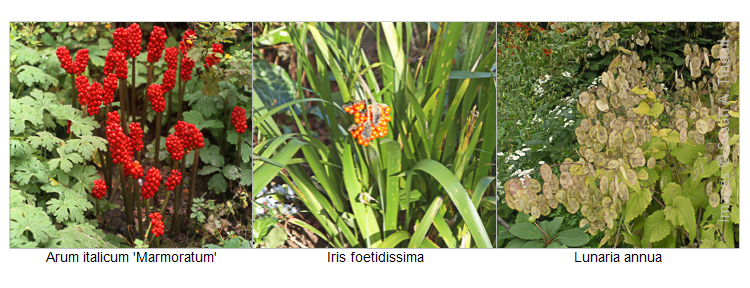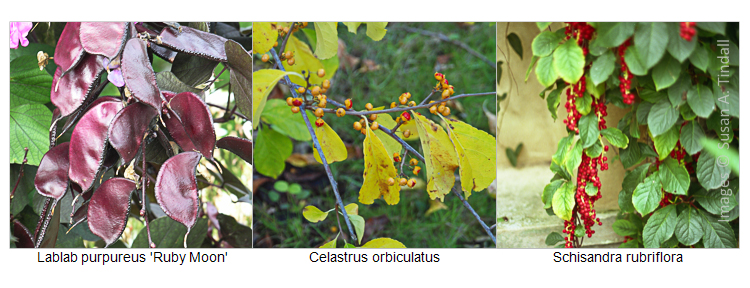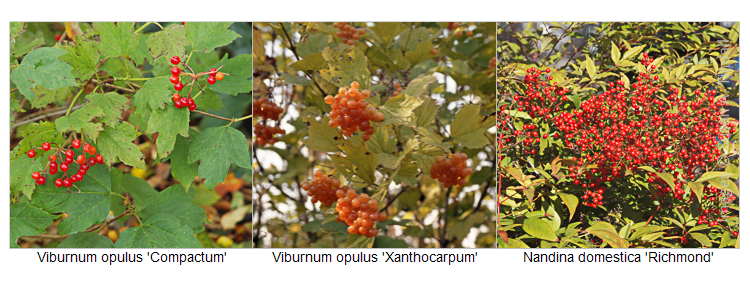Planning Your Small Scale Garden
Part 3 – Ornamental Fruits
Most people love holly with its rich shiny leaves and bright red berries. There are many other plants with highly ornamental fruit that provide interest, often during autumn and winter when flowers are scarce. The following are a few of the many choices available.
Starting small with the summer dormant bulb Arum italicum subsp. italicum ‘Marmoratum’. It has short columns of showy red berries in autumn, followed by marbled leaves that last through winter. Plant this with Hellebores and spring bulbs and it will naturalise if happy. Another lowly, often overlooked plant is the Gladwin iris, Iris foetidissima, with informal clusters of red berries in winter and fan-shaped spikes of green leaves. This is useful in difficult shady or dry places, a plant of quiet quality. Finally try Honesty, Lunaria annua (Also available with showy variegated foliage). The sprays of white or purple flowers are followed by rounded white papery seed pods that appear in summer and which are loved by children.
Moving on to compact and medium-sized shrubs there are new ranges of the Tutsan, Hypericum that have been developed with a resistance to the rust disease that had blighted them. Some of these have names prefixed with ‘Magical’ or ’Miracle’. They are truly eye-candy when the shiny yellow flowers combine with clusters of berries from late summer. The berries are coloured in shades of white, pink, red, and mahogany, all eventually turning black. One example is Hypericum x inodorum Magical Sunshine = ‘Kolmasun’. They make attractive shrubs, around a metre in height with pleasing foliage and a neat shape that looks good in the foreground. Try some of the smaller and sometimes prostrate cotoneasters that have white flowers in May and masses of berries from August or September. The low-growing or prostrate Cotoneaster conspicuus ‘Decorus’ has orange-red autumnal fruits. For a characterful plant, good in a container or enhancing a rockery or raised bed the small but craggy Cotoneaster microphyllus has small red berries that last and last.
Many roses have showy hips (don’t deadhead if you want these to develop), they include the prickly Rosa ‘Fru Dagmar Hastrup’ that has fragrant pink flowers. Finally, the exceptional flagon fruits of red-flowered Rosa ‘Sealing Wax’ stands around 2.5 metres in height but can have lower shrubs planted in the foreground.
Many climbers also have showy fruits. The bold pyracantha is probably the supremo for in-your-face displays of red or orange berries from autumn. Among the number available is Pyracantha Saphyr Orange = ‘Cadange’.
For something different there are the purple autumn pods of the annual climber Lablab purpureus ‘Ruby Moon’. If you are really brave and can handle a 12 metre high climber, there’s the shiny green wall-covering leaves of Celastrus orbiculatus. Its fruits are curious with yellow-lined pods that burst open to show its red berries. For a warm spot the subtle Schisandra rubriflora has dangling red flowers and red fruits, both distinctive and unusual.
If you have room for larger shrubs consider the native guelder rose in the beautiful form Viburnum opulus ‘Compactum’ with clusters of shiny red fruits. The larger Viburnum opulus ‘Xanthocarpum’ is a beauty with its translucent orange berries. For intrigue, try the blue berries of Clerodendrum trichotomum, the large but delicate sprays of red berries on Nandina domestica ‘Richmond, that last all through winter, or, finally, the violet fruit of Callicarpa bodinieri var. giraldii ‘Profusion’, these have a haunting quality all their own, most effective in late autumn.
There are also plenty of ornamental fruits on trees, but these have to wait till next time when ‘Trees for Small Gardens’ will be covered.
Enjoy!
Susan A Tindall





